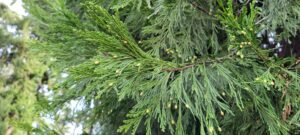Pollen: It’s Not What You Think

When you think of pollen, you probably think of springtime. But for trees, pollen season really starts in December. There’s no need to panic! Eugene Director Erik Burke is here to guide you through everything you need to know about tree pollen, what types of trees are actually allergenic, and what circumstances might carry that pollen to your nose. It shouldn’t surprise you that Erik has deep and extensive tree knowledge. He has been doing research on pollen in particular and wants to let you know: it’s not what you think.
“Many people want to make their tree choice related to pollen,” Erik says. “People tend to think that if it has a showy flower, you’re likely to get allergies, but luckily that’s not really the case.” If a tree has a showy flower, it means that it’s pollinated by insects, and it’s almost impossible to get allergies from it. The trees that give us allergies are wind-pollinated and have non-descript flowers, like incense cedar, which just started putting out its pollen cones.
Without pollen, trees wouldn’t be able to reproduce. For the budding scientists out there: pollen grains are transferred from the anthers of staminate (or “male”) flowers to the stigmas of pistillate (or “female”) flowers, leading to fertilization and the production of seeds. Being able to reproduce naturally is important for trees. It increases their genetic variability and allows them to tap into the creativity of evolution to adapt to local landscapes.
To get their pollen where it needs to go, insect-pollinating trees produce a small amount of pollen that’s very sticky and heavy. It comes out of the flower and falls straight to the ground. When the pollen makes contact with bumblebees, moths, butterflies, or bats, it sticks right to their bodies and is more likely to make its way to a female receptacle.

Wind-pollinated trees—like oaks, ashes, pines, and alders—are responsible for almost all the tree pollen recorded in local pollen counts. Their strategy is to produce a huge amount of pollen that’s light and easily spread by the wind. “They’re just throwing that giant amount out there, hoping it lands on something,” Erik says. That’s their strategy—the more they put out, the better their chances of reproduction.”
The Douglas-fir, a wind-pollinated tree, is the most common tree in the northwest. “Anything in that pine family cooks up huge amounts of wind pollen,” Erik says, “but it’s almost entirely non-allergenic. You might get irritation in your nasal passages from all the particulates but you can’t get allergies from it.”
One of the big complaints that the folks at the Eugene branch hear is that cottonwoods give people allergies. Cottonwoods do have allergenic pollen, but they put out their pollen in February when it’s rainy and cold, so not many people are outside. When people report having allergies from pollen is in April, May and June, when the cottonwood fluff is floating in the air. “Those are the female seeds being dispersed,” Erik says. “But there’s no pollen in the fluff and the pollen’s been gone for at least two months when the fluff comes out.”
They’re more likely allergic to something in the birch family, which puts out pollen in late spring. “In Oregon, the main trees that cause allergies are birch family trees,” Erik says. “We’re talking birches, hazelnuts, horn beams and alders, and those are not commonly planted by Friends of Trees in the Eugene Metro area.”
Weather has a lot to do with how we experience pollen allergies. Trees like the incense cedar are putting out pollen in December, when it’s cold and rainy. Heavy rain will knock the particulates out of the air, cleaning them up for us. Although with some pollen, a light rain can actually break up the pollen granules and make allergies worse. Because we mostly stay indoors in the winter, people don’t really start experiencing allergies until it gets warmer and dryer in April and May.
Since the 1950s, allergy rates in the U.S. have risen from less than 5% of the population to more than 30% today. Overall, however, tree pollen is a minor contributor to allergy issues in our area compared to grass pollen. Eugene is often rated the worst city for allergies in the United States during the grass-pollen peak in the first half of June.
Erik says that allergies should not deter us from planting trees. “It’s possible that trees actually take in more pollen than they release. They hold it on their branches and keep it out of the air.” As always, the solution appears to be more trees.
